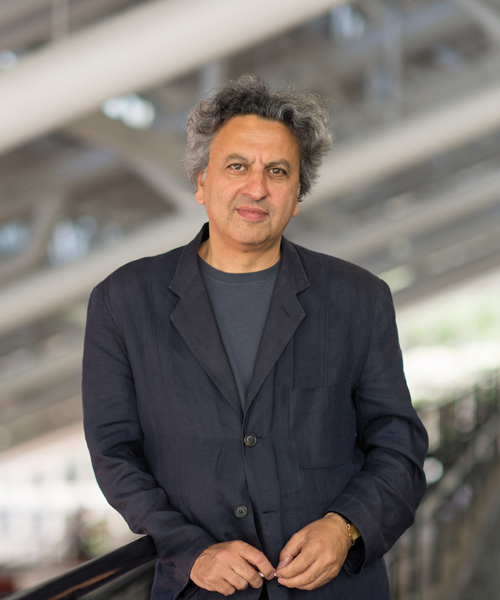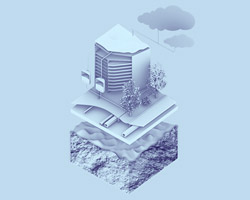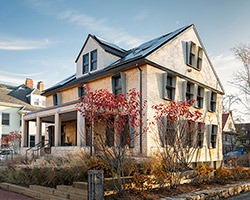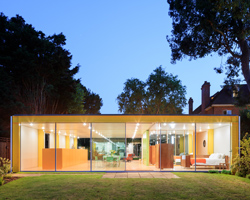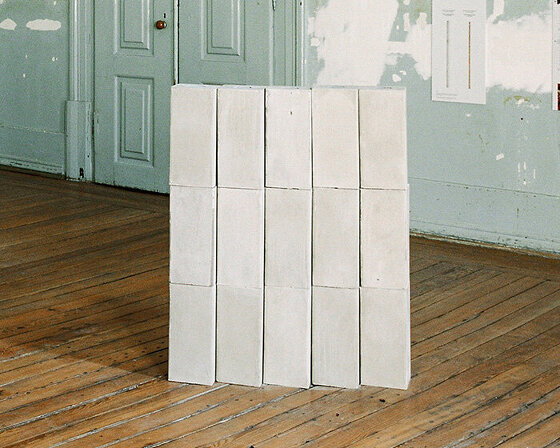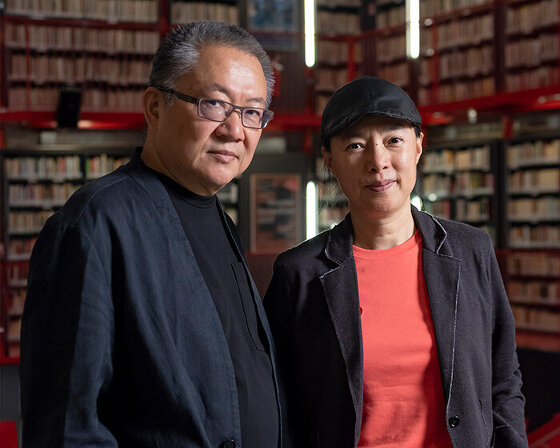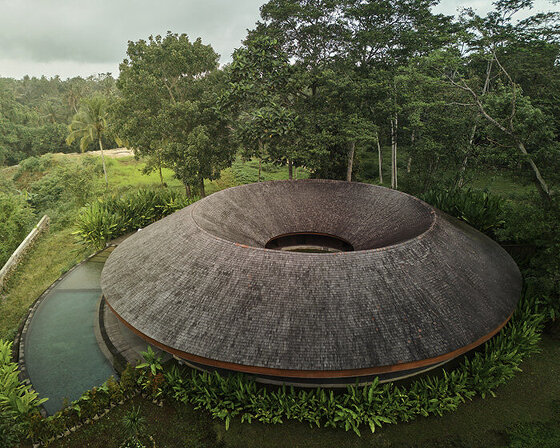architect and educator mohsen mostafavi has written an essay that intends to start a conversation on the future of architectural education. mostafavi is currently the alexander and victoria wiley professor of design at the harvard graduate school of design and previously served as the university’s dean from 2008 through 2019. in the new essay, shared by urbanNext, mostafavi considers the challenges facing the world’s teaching institutions in the wake of the COVID-19 pandemic, exploring a range of pertinent and pressing issues. read the text in full below.
how will we teach next?
notes for a conversation on the futures of architectural education
higher education is at a critical juncture. the ongoing pandemic, with its exponential consequences, has disrupted the sector in significant ways. overnight, for reasons of safety and security, institutions everywhere had to close their doors, send their students away, and begin to teach online. inevitably, faculties have had to go through a steep learning curve. so, too, have the students and the staff who provide administrative, technical, and emotional support. no one knows if the situation will ever return to ‘normal’ pre-pandemic conditions. it probably won’t.
faced with enormous uncertainty about the future, academic institutions are fulfilling their duty of care by spending inordinate amounts of time planning alternative future scenarios. will they continue to teach fully online for the foreseeable future? will they commit to a hybrid or multi-modal model of teaching, combining physical and digital pedagogy? should they bring all their students back to campus? each model has its pros and cons, and different institutions will no doubt adopt different strategies depending on their circumstances, their strengths, and their vulnerabilities. also coming into play are the varied roles of the state and the private sector. the inequities present in some countries make it hard to even imagine the idea of online learning, while in other countries the state’s support of both the healthcare system and education should afford more opportunities.
clearly, students and their families are deeply involved and implicated in these uncertainties. some remain unconvinced about the comparative value of online education both academically and financially. others view the geographically uneven disruptions caused by the pandemic and its political and regulatory impact as reason enough to delay the start or the resumption of their academic careers. still others will want to complete their education as soon as possible and move on to the next phase of their lives – whatever that may hold.
for many academic institutions, this situation will raise severe financial challenges. will they have enough students? and sufficient resources to pay their staff salaries? how can they best protect their investments? how will they safeguard the well-being of their communities? these concerns and more point to the fundamental question of whether many current models for delivering higher education will be sustainable in the years to come.
and yet, every extreme disruption provides a major impetus for rethinking the status quo. one of the unexpected consequences of the global pandemic is the accelerated move towards online research and learning. these opportunities will not only be limited to online courses designed for mass participation, such as MOOCS, but will presumably involve dynamic models of online education combining ‘real time’ and ‘virtual’ content.
one of the potential benefits of these explorations is the ease with which the barrier of geographic distance is overcome, allowing participants from multiple locations to engage in new forms of collaborative teaching and learning – even though early evidence suggests an inevitable prioritization of the time zone of the host institution. equally, such proximities could affect the willingness of future students to travel for educational reasons in the way they have done in the past. students with learning difficulties might also find it harder to cope with their studies without the benefits offered by intellectual and social interactions in physical space.
with the use of zoom, teams, and other platforms, everyone is more punctual and seemingly present and attentive, yet meetings lack the aura and atmosphere of exchange that you have in physical space. the small screen makes it harder to see people’s reactions and register their physical movements and responses. spontaneous conversation gives way to the need to raise one’s hand before making a comment. at the same time, students can become more knowledgeable about each other’s projects, and perhaps even more engaged with them. such is the janus face of the current situation.
much of the discussion of the pandemic within academia has been focused on organizational issues, risk mitigation, and financial sustainability. relatively little attention has been paid to the intellectual, social, and political consequences of online learning. the university as a physical space provides enormous opportunities for overcoming inequity, offering the same access to resources regardless of an individual’s financial status. the continuing use of online education will in all likelihood exacerbate the inequities between students and even faculty and staff. the realities of where people come from, the lack of space at home or the lack of access to childcare, the enormous and important topic of mental health among the student body – all are issues brought into sharp relief by the move to online education. how will academic institutions fulfill their current obligations, including those to their faculties and their families, whose homes have de facto become an offshoot of their institution with the move to online learning? how will these concerns impact the already complex issues of race and gender within the academy? out of sight, out of mind?
collaboration and interaction
the recent experience of online education has also revealed the importance of one of the less visible or talked about aspects of the virtual academy, namely the reduced scope for serendipitous encounters. daily occurrences in physical space, these chance conversations, whether with a friend or a stranger, will become something orchestrated and planned (via chat groups, for example), with less obvious benefits. it is not surprising that in the world of multiple daily zoom meetings, a telephone call has assumed a new level of intimacy as a means of communication.
in any form of collaboration, what is said or debated outside of a formal meeting often matters just as much as, or perhaps even more than, what is discussed during the meeting. the denial of these fortuitous experiences, and more generally of the informal exchange and sharing of ideas in physical space, can add to a sense of loneliness and isolation. in this new situation the relation between the individual and the group is completely transformed. constructing new dialogues and new opportunities for friendship, understanding and engaging with those different from ourselves; these are among the key responsibilities and benefits of the academy. how can these relations be rethought and reconstituted?
architectural and more broadly design education is not immune to these questions and concerns, nor should it be resistant to the opportunities posed by change. architecture’s studio-based model of education, with its reliance on small group, interactive teaching, is particularly susceptible to the complexities of the rapid shift to online teaching. beyond addressing the immediate challenges caused by the pandemic, what lessons can we learn for the future of architectural education? how might the content and structure of the curriculum change to situate design pedagogy within a more fecund and productive cultural, historical, and social context for architecture – one more in tune with our contemporary conditions of life on the planet and at the same time more responsive to the nuances of design issues brought about by the current shift to online education.
drawn and made
one of the more specific and immediate consequences of the closure of architecture school buildings has been the difficulty of making physical models, either as a tool for design development or for the final presentation. without access to workshops and fabrication facilities, students have been unable to use tools such as 3D printers and CNC routers; digital devices that have almost completely replaced models made by hand. what are the consequences of this shift towards virtual means of representation for the ways we imagine future buildings and environments? and when buildings re-open and fabrication facilities resume operation, should everyone return to making models in exactly the same way?
digitally made physical models are generally better finished and demonstrate a higher caliber of aesthetic quality. this is particularly the case with small-scale models that incorporate a high level of detail and visual coherence. their quality is often due to the visible lack of joints between the pieces or elements of the model, something that is almost impossible to achieve by hand. moreover, the logic of assembly of a printed model is not always the same as one made by hand.
in the context of the academy, both physical and digital models are representations of concepts or of buildings assumed – but never actually destined – for construction. these models rarely demonstrate or incorporate the logic of building construction. at the same time, physical models are singular artifacts, things, that also exist in their own right independently of their relation to building.
the tactile experience of the physical model, its material and scale, directly affect the viewer’s sense and perception of the model as a model. the experience of the physical model is always as an artifact and always at a distance from its assumed other, ‘the building.’ still, the physical model can often be experienced and apprehended in its totality in a way that is harder to achieve with a virtual model.
the virtual model on the other hand, as a two-dimensional image of a three-dimensional construct, can never achieve the same tactile qualities as the physical model. there is invariably a tendency towards naturalization and resistance to the analogical qualities of the virtual model, as image – though precisely because of its qualities as image the virtual model is open to manipulations of scale, surface, and texture at a speed that is beyond the reach of a physical model. one can view a digital model as whole, but also as a series of fragments from various points of view, as if photographing a building. ultimately, however, the difference between the physical and the virtual model lies between the experience of an artifact and of an image.
what will be the consequences for architectural education, and ultimately for architecture, of an increasing reliance on images at the expense of the production of physical models as analogical artifacts? and how will the mediation of these images influence their production? do the realities and pressures of digital communication imply a greater need for the desirability and seductive qualities of images? the potential role and explorations of architectural form and its affects, caught between physical and virtual models, is one of many issues brought to the fore as a consequence of recent events. but this discussion also transcends the question of the model and touches on the fundamental differences and tension between things drawn and things made – a topic that is at the core of architecture as a discipline.
geometry and technologies of representation
more broadly, the discussion of images vs. fabrications touches on the interconnections between technologies of representation and architectural ideas. while the development of architectural computation and software tools within contemporary mainstream practice has been primarily focused on building delivery systems, within the academy and some practices these developments have been more directly linked to alternative approaches to design that explore non-euclidean geometry, and in particular the use of organic and fluid forms. both the design drawings and the virtual and physical models associated with non-linear geometry are not only made possible but are also influenced by the application of various types of software such as rhino and grasshopper.
the role of design in contemporary architectural education oscillates between linear and non-linear geometry. the architectural manifestations of these practices range from an architecture of reticence to an architecture of exuberance – from those who seek geometric and material simplicity and clarity to those who see spatial and material complexity as the appropriate architectural response to contemporary society and systems of manufacturing. pushing architecture and construction to its limits has also resulted in the production of forms that at times resemble those from other industries.
the introduction into architecture of forms and shapes previously associated with the automotive and aeronautical industries has led to developments in the engineering and fabrication of buildings. these changes are often associated with the emergence of new materials or the use of existing materials in new ways. ironically, it is the innovations and advances made in the use of ‘old’ materials like brick and wood which have recently produced some of architecture’s most inspiring ideas. technology and engineering have helped transform brick and wood into new materials.
most schools of architecture, however, do not possess the resources for research into materials and modes of construction, hence the importance of collaborations with practice and the construction industry. the future of architectural education could benefit greatly from a deeper understanding of the diversity of relations between design and materials and modes of construction. the aim should be for schools to act as centers of exploration and speculation based on the knowledge and know-how of available and potential new ways of making – a learning process that need not be limited to buildings. one way to explore these themes would be to place greater emphasis on large-scale physical models or fragments of architectural projects, so as to allow the discussion of materials and of means of construction to play a larger role in the design and thinking of projects within the academy.
in the absence of such explorations, drawings at times assume a degree of expression simply to make up for the lack of the material potential of the built artifact. this situation is also made worse by the decreasing emphasis on construction courses and detailing, a form of knowledge often best gained from people in practice, from those involved on a daily basis with the art of putting buildings together.
the profession
the relation between the academy and the architectural profession has not been devoid of conflict. in many instances, professional bodies have used their power of accreditation to help enforce forms of teaching focused on preparing students for their professional careers. the question of how much the academy should mimic practice has been a contentious topic over the years. should schools of architecture provide a radically different experience of the discipline, or should they provide their students with the knowledge necessary to be fully operational in an office setting on day one? the relative proximity or distance of the academy from practice is a topic that needs to be negotiated and designed based on the circumstances and pedagogic position of individual institutions. what is certain, however, is that the school should not be confused with the profession.
most professional offices define themselves either through degrees of specialization or the specific character of their output, appealing to their clients by virtue of quality, style, or taste. the constraints implicit in such positioning might be too limiting for the majority of students, who need to be encouraged to develop their own domains of interest, for example by completing a thesis in their chosen area or through the selection of their courses and studios.
the potential for productive tension between the academy and the profession places greater emphasis on the scope of the curriculum within schools of architecture. alongside the requirement for greater design and technical knowledge and competency there is a need to link architecture to a broader set of disciplinary and societal issues. in some schools, these two conditions or approaches reveal themselves in stark contrast to each other; the architects, or more specifically the formalist camp, vs. the socially conscious camp. negotiating the balance between these two parameters will be key.
society and transdisciplinarity
architecture cannot address contemporary cultural, economic, and political issues without acknowledging its relation to society. that is why it is imperative for architectural education to promote the simultaneous need for disciplinary knowledge and transdisciplinary forms of practice. such an approach necessitates not only the collaboration of other design disciplines such as planning, landscape architecture, and urban design but also the involvement of many other fields of knowledge.
equally, it is only by understanding how societies work and what they need that architects will be able to find a greater and more effective voice for change. both design education and the profession need to recognize that architecture is inherently political, otherwise we will forever be viewed merely as a service sector. while this is not to say that architecture does not provide a service, we need to be at the table discussing and shaping ways in which architecture and urbanization can contribute to the wellbeing of citizens both emotionally and physically. from considerations of climate change to sustainability, from social justice to equity, architects should be able to demonstrate the importance and contributions of design and the built environment. these forms of engagement require the understanding and articulation of the differences between politics and the political.
situating architecture within this larger social and political context is one of the primary responsibilities of architectural education. schools cannot rely on the old recipes and solutions for addressing the agonistic and conflictual character of contemporary urbanization. instead the academy must constantly reconsider, debate, and redesign its prevalent narratives and methodologies. it is the shared responsibility of faculty and students to discuss curricular issues to enhance the knowledge of architecture and its capacities for responding to societal transformation. design is inseparable from the political.
the curricular and the extra-curricular
the curriculum of most schools of architecture in europe and united states is still largely influenced by the lineage of the modern movement. the curriculum in part affects the hiring practices of institutions, and the faculty in turn define and decide the educational policies. responding to current environmental, social, and political realities requires a deliberate effort on the part of everyone involved to think afresh about the way in which each institution, within the limits of its own capacities, can participate in the project of rethinking the responsiveness and relevance of its curriculum and mode of pedagogy. how might the radical and visionary experiences of the bauhaus, the black mountain college, and other experimental and collaborative forms of design pedagogy be debated and revised to address our contemporary needs and conditions? what lessons can we learn from the adjacency of architecture to the arts, to history and issues involving tangible and intangible heritage?
the curriculum of most schools of architecture is made up of courses on design, history and theory, technology, representation and practice. typically there is little interaction between these subjects, and little serious engagement either with its audience – the students – or with wider cultural and societal concerns. to some degree the necessary autonomy of the curriculum would benefit from its contamination with reality, from addressing the specificity of the people and locations that form the imaginary sites of an architectural project within the academy. how can the curriculum reflect the dilemmas of our own modernities?
diversity and difference
related to these topics is the changing character of the student body, who they are, and what values they represent. in this context, teaching is not an abstraction but happens in relation to an individual student or groups of students. in some parts of the world the student body has remained relatively homogeneous, perhaps distinguished only by financial and class differences. in other parts of the world, for example in europe, the advent of the erasmus program in 1987 marked the beginning of an important cultural and academic experiment in cross-fertilization and interaction, enabling students to move between more than 30 program countries.
one of the great benefits of studying architecture at graduate level in north america is the diversity of pathways for entry, bringing together people with and without a professional degree. the typical MArch I program admits students, often from a liberal arts background with some or little experience in design, as well as those with two or four years of architectural education, while MArch II programs cater for applicants who have completed a five-year course of study in architecture. since admission includes the evaluation of a portfolio it can be hard for a faculty member involved in the process to resist placing a candidate with a lot of design experience above one without. the tendency towards the ‘professionalization’ of pedagogy is therefore reflected even in the admissions process. but in order for US and canadian models of the MArch program to benefit from the diverse prior academic experience of their students they must always be aware of the intellectual and cultural mix of their admitted students. the differences between the students greatly enhances the range of topics for consideration as well as their capacity for learning from each other.
in the united states, changing demographics as well as an increasing proportion of foreign students have produced a complex, exciting, and potentially productive set of challenges for architectural education. furthermore, as the impact of COVID-19 makes clear, academic institutions and their pedagogy are subject to a diverse range of external forces. these include the impact of the financial markets and the economy, immigration policies, racial and social justice, government attitudes and regulations, environmental and public health risks. each of these conditions affects the education system either implicitly or explicitly.
historically, for example, the list of curriculum requirements for architectural accreditation has included a course on non-western or world architecture. this type of course can often be seen as a form of tokenism. if architectural education wants to be relevant it should respond actively and with enthusiasm to the realities of our societal conditions. what should be the response of the academy to african american and latinx students who have made the commitment to studying architecture especially at a time when the spaces of so many cities are so highly racialized? what are the conditions, for example, that will best provide the intellectual and technical tools for these future architects to overcome the anti-black sentiments of our society and by extension our profession? what might be the spatial consequences of the response to black lives matter? these conditions, together with the profession’s generally low financial remuneration structure, have dissuaded many minorities from joining the design profession. the incredibly low number of african american architects and landscape architects currently practicing in the united states is a testament to this situation. the situation is particularly extreme with african american women architects, who make up a mere 0.03% of all licensed architects in the united states. these questions cannot be answered by simply modifying the curriculum, though that is surely part of the process. a diverse curriculum requires a faculty who represent to the greatest degree possible the diverse demographics of the country in which the school is based. the curriculum also requires a rethinking of the themes and topics of pedagogy in ways that transcend the limits of national boundaries. how will these considerations affect the teaching of architectural history, its content and its geographies? or how will practice courses incorporate the profession’s political and ethical dimensions? the curriculum must imagine a different image of an architect than the one we have inherited from the past. the new architect will need to be at once a citizen and a designer – an engaged social being with the capacity to imagine better futures.
fluid geographies, affiliations and the environment
over the past ten years the number of chinese students wishing to study architecture in the US has increased dramatically. in most major schools of architecture, the proportion of chinese students far outnumber those of other countries. yet, only a few years ago, it was korean and canadian students who topped the list of foreign architecture students. the increase in the number of chinese students goes hand in hand with the chinese government’s concerted investment in the education sector and the exponential growth in the number of its citizens able to afford the cost of private education in the US. the government’s investment in education has been instrumental in improving the quality of local architecture and design schools, which now invariably work in partnership with other schools around the globe. given this context, how should schools in the US modify their program to best prepare to respond to the dynamic and fluid composition of their student body, not only those from china but also others from india, latin america, africa, and the rest of the global south? how will the themes or points of focus of pedagogy change when faced with radically different audiences as well as processes of urbanization as the sites for architecture? what lessons can architecture learn from the outcomes? how can engaging with these fluid geographies make us more sensitive to the relation between the creation of new habitats and their environmental consequences?
one argument would be for architecture schools to focus on instilling modes of thinking and practice that will enable their students to respond to the realities of different cultures and geographies. while that is a valid and positive strategy, it is equally true that architectural education would benefit from learning how to gauge the conditions for contemporary practice within a diverse range of situations, whether near or far. the dynamics of both the cohort of students and the impact of external forces will need to be considered and addressed by the full academic community as part of an ongoing project of reviewing the school’s pedagogy.
other possibilities include new forms of collaboration and exchange with institutions with radically different geographies and programs. there are currently relatively few schools of architecture in africa. those that exist are generally divided between the ones in arabic speaking north africa, with their roots primarily in the french system of architectural education, and those in the rest of the continent. the majority of these schools, perhaps with the exception of some in south africa, operate with limited resources, both financially and in terms of the number of faculty. the lack of resources has resulted in a country like burkina faso not even having a school of architecture.
collaboration and interaction in this context could lead to the exploration of a diverse body of topics, ranging from the construction of modest yet innovative structures in conjunction with local communities, to the understanding of urbanization’s extreme and uneven forms of development. besides benefiting existing institutions, such collaborations could pave the way for the formation of new schools of architecture on the african continent. similar approaches could be envisaged in the context of the caribbean, where the region’s accessibility has already allowed for the formation of a number of important medical schools. these developments might provide a relevant point of reference for a discussion of the future of architecture and planning education in ways that support a genuine and critical understanding of climate and geography as well as the needs of the community – yet without repeating the mistakes of some of the practices imported from the united states.
academic strategies for the future should no longer be based on the hegemony of any style and its application to different geographies. instead they must presuppose an architecture that is sensitive to specific cultural, political, and physical geographies, in the process transcending the pitfalls of both localism and globalization. this architecture – and, with it, this architectural education – must possess a worldliness and a frame of mind that is in constant dialogue with other disciplines and other voices, conflictual as well as conciliatory. it is only then that architectural education can add and contribute to both architectural knowledge and to society at large.
édouard glissant, the martinican/french poet, theorist, and thinker, developed his ‘poetics of relations’ as a means of exploring ‘relational belonging as a decolonial intervention’. urging us to move ‘beyond the oppositional discourse of the same and the other’, he instead proposed an idea of difference made up of an assembly of ‘dissimilar’ things. his argument enables relations between ‘different people and places, animate and inanimate objects, visible and invisible forces, the air, the water, the fire, the vegetation, animals and humans’.
glissant’s ‘poetics of relations’ is also a means of responding to the criticism and reaction to globalization made increasingly visible today through forms of neo-localism and neo-nationalism. glissant’s concept of mondialité – of worldliness or worldmentality – is based on a philosophy of post-filiation when the mind is situated in a body that exists in relation to the world. creolization, and the idea of porous or permeable borders between nations, are two examples of glissant’s notion of mondialité that stand in contrast to the impacts of globalization and various forms of neo-liberal policies and are without some of the negative associations of the figure of the cosmopolitan and of cosmopolitanism, for example.
in the glissantian ‘worldmentality’ relation and difference are co-dependent elements that benefit from each other’s energy. and within the context of the architecture academy, much could be gained from a deeper engagement with the cultural and physical geographies of both students and faculty. how will such considerations affect the selection of sites for a design studio? how will the cultural conditions of a site affect the choice of the program and shape the design?
the dramatic spatial consequences of the current pandemic, its impact on both cities and buildings, will undoubtedly affect the way designers consider the future of architecture and urban development. it will also result in a greater degree of sensitivity within the academic community towards the connections between health and the built environment. from considerations of density to those of rural development, from questions of infrastructure and transportation to healthy buildings and places – these and other research topics will undoubtedly receive greater attention.
on the other hand, one of the most important lessons of the past few months with COVID-19 has been to witness the power of sharing ideas, of collaboration and the willingness to experiment with new ways of doing things. it is imperative for both practice and the academy to seize the moment. in the world of architectural education such an ethos of togetherness – based on both openness and hospitality – would enable a radical rethinking of the links between pedagogy and society. the artifice of architecture in conjunction with the knowledge and contribution of other disciplines could then help reimagine spaces and places that truly respond to the needs and aspirations of people with ‘dissimilar’ backgrounds. the commitment to such ‘politics of difference’ is the only way for architecture and design more generally to participate in its own ‘poetics of relations’ and contribute to the making of a just and equitable society. — mohsen mostafavi, 2020
